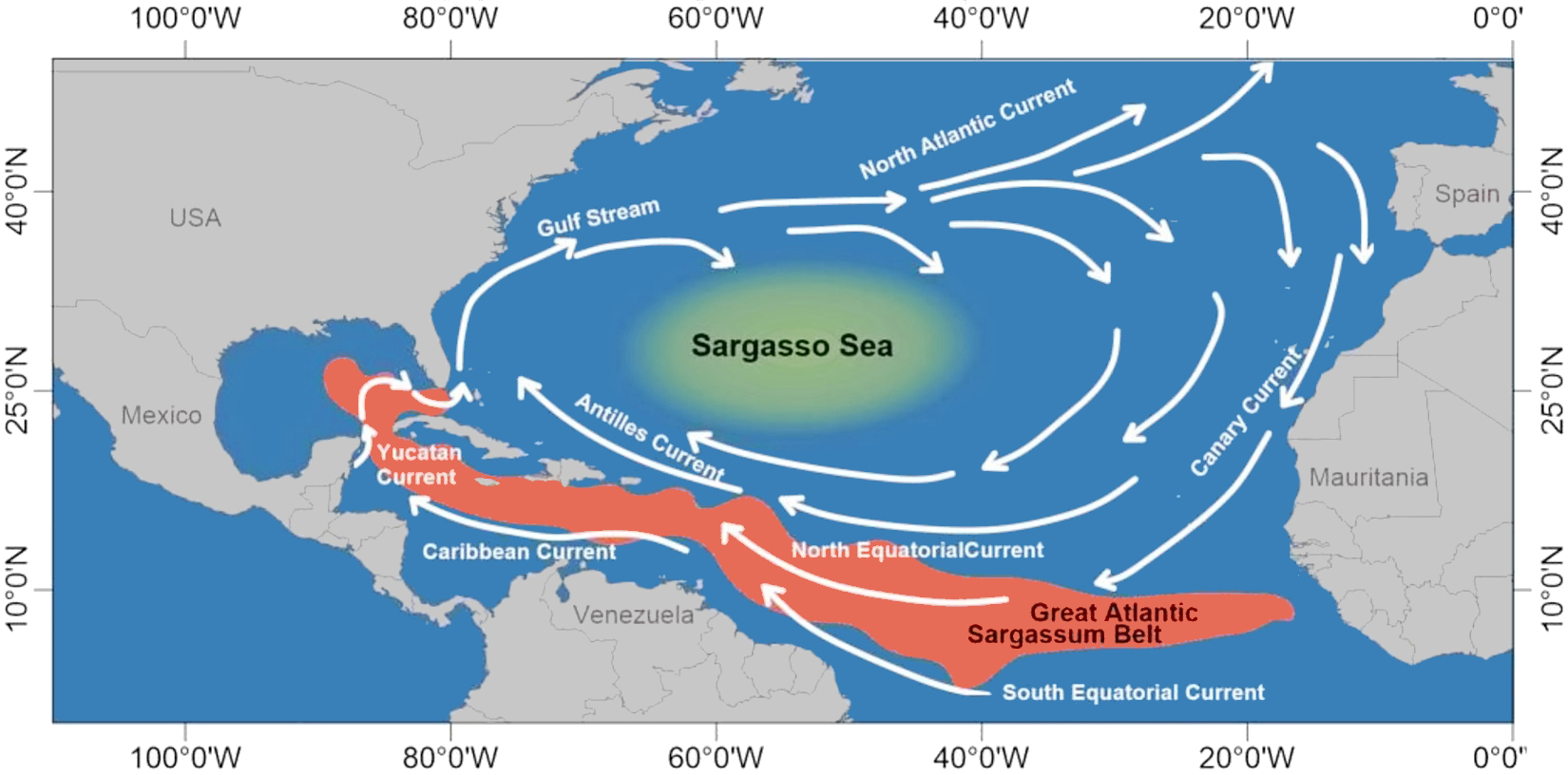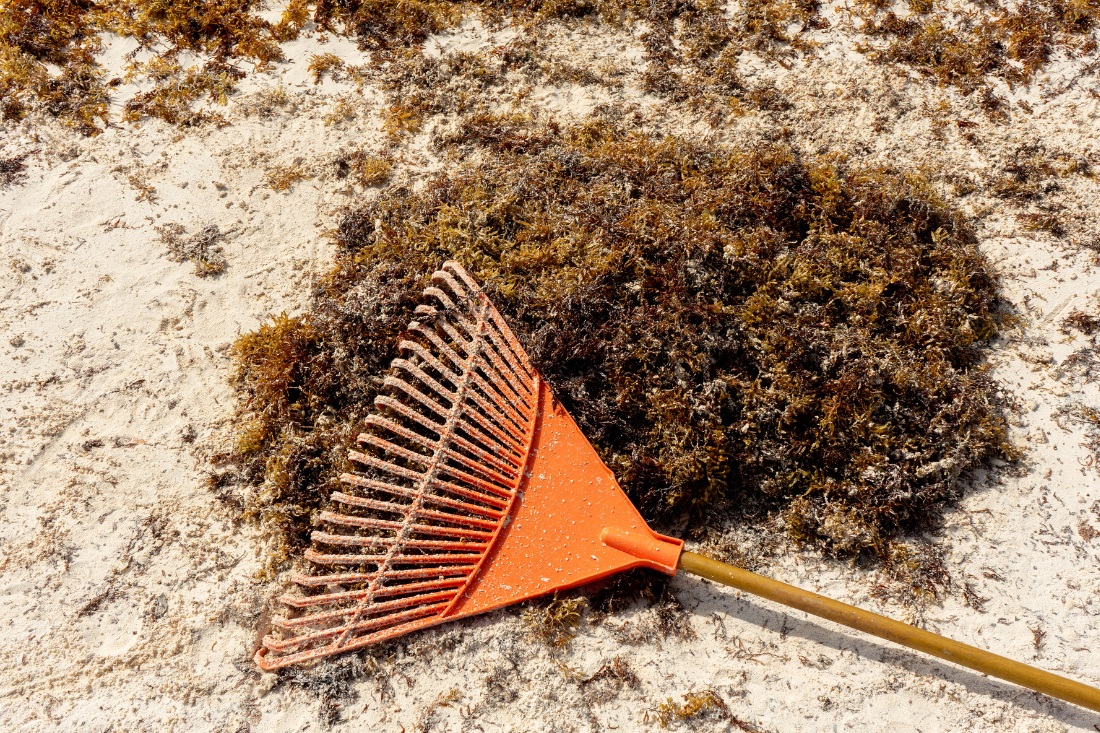A colossal 5,000-mile-wide sargassum blob is causing concern for Florida’s coastline, as well as the Caribbean and parts of the Gulf of Mexico. This massive seaweed accumulation is raising several questions and concerns for both the environment and local economies. Here are some of the most frequently asked questions about the Sargassum invasion:
What is the sargassum blob, and where is it coming from?

The Great Atlantic Sargassum Belt, depicted alongside the Sargasso Sea and significant currents in the North Atlantic. Credit: Wikipedia
The sargassum blob is a massive accumulation of brown, branching seaweed called sargassum. Originating from the Great Atlantic Sargassum Belt, patches of this weed now span large parts of the Atlantic Ocean.
Sargassum is typically found in the Sargasso Sea, but recent changes in ocean conditions have caused it to proliferate and accumulate along coastlines.
Why is the sargassum blob a problem?
The sargassum blob is problematic for various reasons. The seaweed emits hydrogen sulfide gas as it decomposes, producing a rotten-egg like odor that can cause respiratory irritation and other health issues. Massive sargassum blooms also negatively impact coastal ecosystems, degrading water quality, clogging coral reefs, and depleting oxygen levels, which can lead to the death of marine life.
Will the blob affect the Gulf Coast of Florida near Scenic Highway 30A?
The huge “sargassum blob” in all the headlines is primarily impacting Florida’s Atlantic Coast. It is possible that some areas along the Gulf Coast may experience sargassum accumulation, but this particular mass is unlikely to reach the shores along Scenic 30A.
Is sargassum dangerous to humans?

While sargassum is not inherently dangerous to humans, exposure to the hydrogen sulfide gas it emits can cause headaches, poor memory, tiredness, and balance problems.
The Florida Department of Health also advises against consuming sargassum due to the possible presence of heavy metals like arsenic and cadmium.
How does this affect travel and tourism?
Sargassum accumulation can have a significant impact on travel and tourism, as the seaweed and its accompanying odor can deter visitors from enjoying affected beaches. This can lead to a decline in tourism revenue for affected areas. Resorts and other tourist destinations in regions like Florida, the Caribbean, and Mexico are preparing for the challenge by investing in sargassum removal efforts.
What is causing the sargassum blob?
The exact cause of the sargassum blob is not fully understood, but factors such as nutrient pollution and climate change are believed to contribute to its increasing severity. Agricultural runoff, sewage, and deforestation can introduce nutrients into the ocean, fueling the rapid growth of algae. Additionally, warmer waters, shifts in marine overturn, and increased rainfall from climate change may also exacerbate the problem
How do you clean up sargassum?

Cleaning up sargassum typically involves the use of farm equipment or manual labor to remove the seaweed from affected beaches. Resorts and beach owners often work tirelessly to clear the seaweed to maintain the cleanliness of their beaches.
Does everyone agree this is a big problem?
While many people are concerned about the sargassum blob, some experts argue that the situation is not as dire as some headlines suggest. Dr. Yuyuan Xie, an oceanographer at the University of South Florida, explains that the 5,000-mile Great Atlantic Sargassum Belt is comprised of less than 0.1% seaweed, with the remaining 99.9% being Sargassum-free ocean water (Karlis, Salon).
According to Xie, only a tiny portion of the seaweed within the belt is expected to reach Florida’s east coast and the Florida Keys.
While the increase in sargassum is unusual compared to a decade ago, it aligns with the behavior observed over the past five years, suggesting that this might be the “new normal.“
As researchers continue to monitor the sargassum blob and its impact on coastal regions, it is essential to remain vigilant and prepared for the challenges it may present. The sargassum invasion is a stark reminder of the complex and interconnected consequences of human activities on our planet’s ecosystems.


